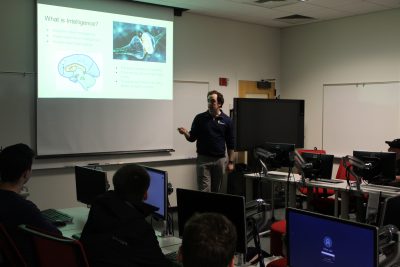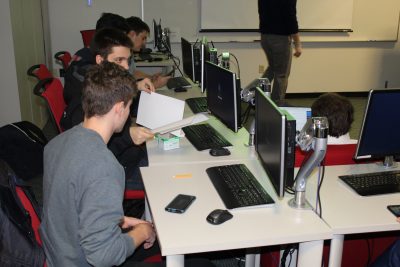 On Friday, February 15th, OPIM Innovate held its Introduction to Artificial Intelligence (A.I.) Workshop from 1:00 PM to 3:00 PM in the Gladstein Lab, BUSN 309. Led by Stephen Fitzgerald, an adjunct professor in the Operations and Information Management (OPIM) Department, the workshop covered various aspects of artificial intelligence, including neural networks and evolutionary computing. As Professor Fitzgerald explained during the workshop, “A lot of intelligence as far as artificial intelligence goes is modeled after human intelligence–the way that humans make decisions, and the way that they think about things.” However, throughout the workshop, students learned that these models are more mathematical than contextual. In other words, machines do not have the capacity to understand complex ideas, but this does not always mean that they cannot perform tasks better.
On Friday, February 15th, OPIM Innovate held its Introduction to Artificial Intelligence (A.I.) Workshop from 1:00 PM to 3:00 PM in the Gladstein Lab, BUSN 309. Led by Stephen Fitzgerald, an adjunct professor in the Operations and Information Management (OPIM) Department, the workshop covered various aspects of artificial intelligence, including neural networks and evolutionary computing. As Professor Fitzgerald explained during the workshop, “A lot of intelligence as far as artificial intelligence goes is modeled after human intelligence–the way that humans make decisions, and the way that they think about things.” However, throughout the workshop, students learned that these models are more mathematical than contextual. In other words, machines do not have the capacity to understand complex ideas, but this does not always mean that they cannot perform tasks better.
 After a brief overview of the different areas and categories of artificial intelligence, students were paired up for an introductory activity. During this activity, one student from each group was told to keep their head down while the other student was shown a picture on the projector screen. Once the picture was covered back up, the students who had seen the image were told to explain to their partners how to draw it without context (for example, you could not say “cat” or “falling”). Instead, they could only explain things mathematically in angles, degrees, and shapes, mimicking the understanding of a computer. Both partners had an opportunity to draw and give directions, and many students were scratching their heads in the process. The photo on the left is of the drawings I and junior finance major Christopher Narkon were able to conjure up. Given the two tails I drew on what is obviously a cat, thinking like a machine can make understanding the world very difficult.
After a brief overview of the different areas and categories of artificial intelligence, students were paired up for an introductory activity. During this activity, one student from each group was told to keep their head down while the other student was shown a picture on the projector screen. Once the picture was covered back up, the students who had seen the image were told to explain to their partners how to draw it without context (for example, you could not say “cat” or “falling”). Instead, they could only explain things mathematically in angles, degrees, and shapes, mimicking the understanding of a computer. Both partners had an opportunity to draw and give directions, and many students were scratching their heads in the process. The photo on the left is of the drawings I and junior finance major Christopher Narkon were able to conjure up. Given the two tails I drew on what is obviously a cat, thinking like a machine can make understanding the world very difficult.
As the workshop continued, one student brought up a good point that resonated with Professor Fitzgerald: due to a machine’s immense computing power and inability to comprehend distracting stimuli, it oftentimes has the upper hand regarding task accuracy. Machines can learn from mistakes, become as precise as possible with the steps they choose for task completion, and create preemptive and accurate decision maps. As such, projects like Deep Blue, Alpha Go, and AlphaStar have been able to beat the world’s best strategy-game players in games like chess, Go, and Starcraft.
 After the workshop, students were left baffled with how immense the world of artificial intelligence has become. One student, junior MIS major James Mercaldo, stated, “I didn’t know there were a lot of hidden stages in machine learning. I always thought it was a fixed, input/output thing.” Yunqian Zuo (’22), a management and engineering for manufacturing major, added, “I didn’t know there were so many different branches [in artificial intelligence].”
After the workshop, students were left baffled with how immense the world of artificial intelligence has become. One student, junior MIS major James Mercaldo, stated, “I didn’t know there were a lot of hidden stages in machine learning. I always thought it was a fixed, input/output thing.” Yunqian Zuo (’22), a management and engineering for manufacturing major, added, “I didn’t know there were so many different branches [in artificial intelligence].”
For students who want to learn more about artificial intelligence, OPIM Innovate has tech kits that can be individually completed at your own pace.
Thank you to everyone who came to the Introduction to A.I. workshop. We hope you had a wonderful time!